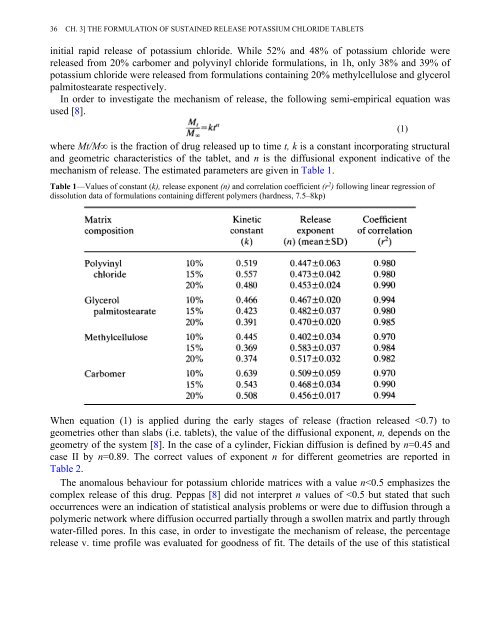- Page 2 and 3: PHARMACEUTICAL TECHNOLOGY Controlle
- Page 4 and 5: 3 TABLET MACHINE INSTRUMENTATION IN
- Page 6 and 7: First published in 1991 by ELLIS HO
- Page 8 and 9: 7 10 Controlled delivery of theophy
- Page 10: Slow and steady wins the race Poems
- Page 14 and 15: 1 Influence of drug solubility in t
- Page 16 and 17: CH. 1] INFLUENCE OF DRUG SOLUBILITY
- Page 18 and 19: CH. 1] INFLUENCE OF DRUG SOLUBILITY
- Page 20 and 21: CH. 1] INFLUENCE OF DRUG SOLUBILITY
- Page 22: CH. 1] INFLUENCE OF DRUG SOLUBILITY
- Page 25 and 26: 24 MATRIX FORMULATIONS [CH. 2 MATER
- Page 27 and 28: 26 MATRIX FORMULATIONS [CH. 2 Fig.
- Page 29 and 30: 28 MATRIX FORMULATIONS [CH. 2 Table
- Page 31 and 32: 30 MATRIX FORMULATIONS [CH. 2 The e
- Page 33 and 34: 32 MATRIX FORMULATIONS [CH. 2 Table
- Page 35: 34 CH. 3] THE FORMULATION OF SUSTAI
- Page 39 and 40: 38 CH. 3] THE FORMULATION OF SUSTAI
- Page 41 and 42: 40 CH. 3] THE FORMULATION OF SUSTAI
- Page 44 and 45: 4 Statistical optimization of a con
- Page 46 and 47: MATRIX FORMULATIONS [CH. 4 45 (4) G
- Page 48 and 49: MATRIX FORMULATIONS [CH. 4 47 Fig.
- Page 50 and 51: Columns 1-4 lead to the matrix of e
- Page 52 and 53: MATRIX FORMULATIONS [CH. 4 51 Table
- Page 54 and 55: MATRIX FORMULATIONS [CH. 4 53 Fig.
- Page 56: Fig. 5—Linearization of the relea
- Page 59 and 60: 58 MATRIX FORMULATIONS [CH. 5 Pevik
- Page 61 and 62: 60 MATRIX FORMULATIONS [CH. 5 The d
- Page 63 and 64: 62 MATRIX FORMULATIONS [CH. 5 Fig.
- Page 65 and 66: 64 MATRIX FORMULATIONS [CH. 5 Fig.
- Page 67 and 68: 66 MATRIX FORMULATIONS [CH. 5 Table
- Page 69 and 70: 68 MATRIX FORMULATIONS [CH. 5 Fig.
- Page 72 and 73: 6 Controlled release matrix tablets
- Page 74 and 75: CH. 6] CONTROLLED RELEASE MATRIX TA
- Page 76 and 77: CH. 6] CONTROLLED RELEASE MATRIX TA
- Page 78 and 79: CH. 6] CONTROLLED RELEASE MATRIX TA
- Page 80 and 81: 7 A new ibuprofen pulsed release or
- Page 82 and 83: CH. 7] A NEW IBUPROFEN PULSED RELEA
- Page 84 and 85: CH. 7] A NEW IBUPROFEN PULSED RELEA
- Page 86 and 87:
CH. 7] A NEW IBUPROFEN PULSED RELEA
- Page 88:
CH. 7] A NEW IBUPROFEN PULSED RELEA
- Page 91 and 92:
90 CH. 8] TOPICAL RELEASE AND PERME
- Page 93 and 94:
92 CH. 8] TOPICAL RELEASE AND PERME
- Page 95 and 96:
94 CH. 8] TOPICAL RELEASE AND PERME
- Page 97 and 98:
96 CH. 8] TOPICAL RELEASE AND PERME
- Page 99 and 100:
98 CH. 8] TOPICAL RELEASE AND PERME
- Page 101 and 102:
100
- Page 103 and 104:
102
- Page 105 and 106:
104 MULTIPARTICULATES [CH. 9 parace
- Page 107 and 108:
106 MULTIPARTICULATES [CH. 9 (a) th
- Page 109 and 110:
108 MULTIPARTICULATES [CH. 9 Fig. 2
- Page 111 and 112:
110 MULTIPARTICULATES [CH. 9 Fig. 6
- Page 113 and 114:
112 MULTIPARTICULATES [CH. 9 Fig. 7
- Page 115 and 116:
114 MULTIPARTICULATES [CH. 9 Fig. 8
- Page 117 and 118:
116
- Page 119 and 120:
118 CH. 10] CONTROLLED DELIVERY OF
- Page 121 and 122:
120 CH. 10] CONTROLLED DELIVERY OF
- Page 123 and 124:
122 CH. 10] CONTROLLED DELIVERY OF
- Page 125 and 126:
124 CH. 10] CONTROLLED DELIVERY OF
- Page 127 and 128:
126 CH. 11] THE EFFECT OF FOOD ON G
- Page 129 and 130:
128 CH. 11] THE EFFECT OF FOOD ON G
- Page 131 and 132:
130
- Page 133 and 134:
132 CH. 12] BIODEGRADABLE POLYMERS
- Page 135 and 136:
134 CH. 12] BIODEGRADABLE POLYMERS
- Page 137 and 138:
136 CH. 12] BIODEGRADABLE POLYMERS
- Page 139 and 140:
138 CH. 12] BIODEGRADABLE POLYMERS
- Page 141 and 142:
140
- Page 143 and 144:
142 CH. 13] A COMPARISON OF DISSOLU
- Page 145 and 146:
144 CH. 13] A COMPARISON OF DISSOLU
- Page 147 and 148:
146 CH. 13] A COMPARISON OF DISSOLU
- Page 149 and 150:
148 CH. 13] A COMPARISON OF DISSOLU
- Page 151 and 152:
150 CH. 13] A COMPARISON OF DISSOLU
- Page 153 and 154:
152
- Page 155 and 156:
154
- Page 157 and 158:
156 OPHTHALMIC FORMULATION [CH. 14
- Page 159 and 160:
158 OPHTHALMIC FORMULATION [CH. 14
- Page 161 and 162:
160 OPHTHALMIC FORMULATION [CH. 14
- Page 163 and 164:
162 CH. 15] A SUSTAINED RELEASE OPH
- Page 165 and 166:
164 CH. 15] A SUSTAINED RELEASE OPH
- Page 167 and 168:
166 CH. 15] A SUSTAINED RELEASE OPH
- Page 169 and 170:
168 CH. 15] A SUSTAINED RELEASE OPH
- Page 171 and 172:
170
- Page 173 and 174:
172 IMPLANTS [CH. 16 The purpose of
- Page 175 and 176:
174 IMPLANTS [CH. 16 times with 5 m
- Page 177 and 178:
176 IMPLANTS [CH. 16 noted that the
- Page 179 and 180:
178 IMPLANTS [CH. 16 Fig. 1—The e
- Page 181 and 182:
180 IMPLANTS [CH. 16 Table 3—Tobr
- Page 183 and 184:
182
- Page 185 and 186:
184 CH. 17] SILICON MATRIX SYSTEMS
- Page 187 and 188:
186 CH. 17] SILICON MATRIX SYSTEMS
- Page 189 and 190:
188 CH. 17] SILICON MATRIX SYSTEMS
- Page 191 and 192:
190 CH. 17] SILICON MATRIX SYSTEMS
- Page 193 and 194:
192
- Page 195 and 196:
194 INDEX dry granulation, 43 elect

















